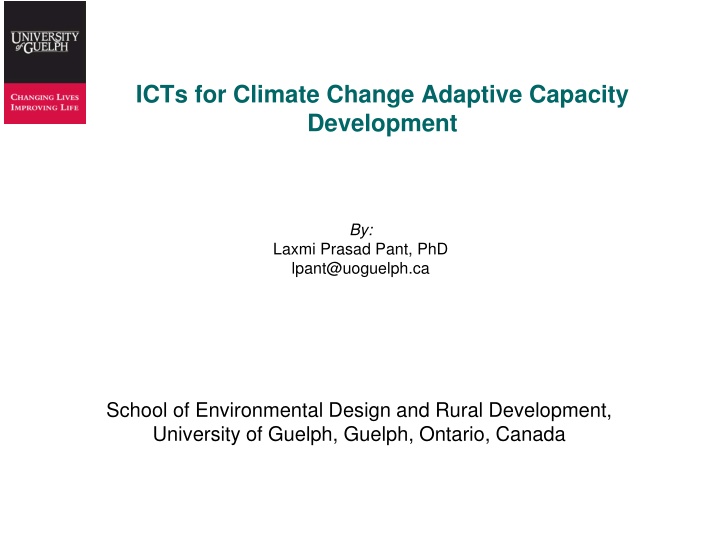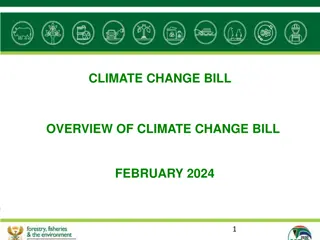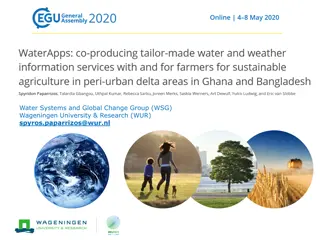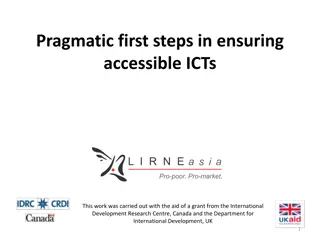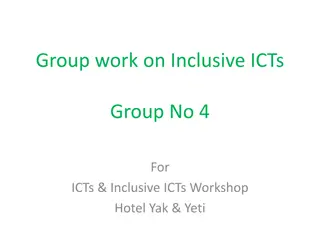Enhancing Climate Change Adaptive Capacity Through ICTs
Developing adaptive capacity to address climate change in vulnerable communities is crucial. Integrating expert and local knowledge using Information and Communication Technologies (ICTs) can help, but challenges like digital exclusion must be overcome. Understanding climate change as a complex problem and implementing deliberate and emergent adaptation strategies are key. Bridging the digital divide and leveraging transformational capacity are essential for effective climate change resilience. Utilizing emerging ICT infrastructure archetypes and case studies can offer valuable insights for developing adaptive solutions.
Download Presentation

Please find below an Image/Link to download the presentation.
The content on the website is provided AS IS for your information and personal use only. It may not be sold, licensed, or shared on other websites without obtaining consent from the author.If you encounter any issues during the download, it is possible that the publisher has removed the file from their server.
You are allowed to download the files provided on this website for personal or commercial use, subject to the condition that they are used lawfully. All files are the property of their respective owners.
The content on the website is provided AS IS for your information and personal use only. It may not be sold, licensed, or shared on other websites without obtaining consent from the author.
E N D
Presentation Transcript
ICTs for Climate Change Adaptive Capacity Development By: Laxmi Prasad Pant, PhD lpant@uoguelph.ca School of Environmental Design and Rural Development, University of Guelph, Guelph, Ontario, Canada
Overview A need to develop climate change adaptive capacity of vulnerable communities, e.g., National Adaptation Programme of Action (NAPA). One source of adaptive capacity is expert and local knowledge integration, and ICTs can facilitate this process. But ICTs, the proposed solutions, have their own problems due to the digital vicious cycle, digital exclusion leads to social exclusion, and vice versa.
Climate Change: A Complex Problem Climate change Snowden. and Boone (2007)
Complex Systems: Self-Organising Systems Interacting elements. Non-linear interactions. Emergent properties, 2+2 4. Self-organizing systems.
Climate Change Adaptation Strategies: Deliberate and Emergent
Two Main Sources of Climate Change Adaptive Capacity Loop 2: Transformational capacity Breaking the digital vicious cycle Bridging the digital divide Loop 1: informational capacity
Emerging Archetypes of ICT Infrastructure 1. Advanced Internet . 2. Ordinary mobile phone. 3. Remote Internet Access, such as Telecentres. 4. Mobile phone + telecentre. 5. Emerging ICTs + community radio, face-to-face interaction.
Case Studies Ubiquitous use Flood Warning Systems. Weather forecasting, fishing zones, market information, cultivation practices. Short messaging services (SMS). Experimental use Food security monitoring. Disease surveillance. Household survey about insecticide treated bednets. Luxurious use; not even experimental Multimedia messaging service (MMS). Based on eight projects across nine countries in Africa, South Asia and Latin America.
Examples of Deliberate and Emergent Adaptation Strategy Intended Deliberate strategy, e.g., early warning systems. Unintended Anticipatory Effective in simple and complicated systems Autonomous Emergent strategy, e.g., agriculture and health information systems. Effective in complex adaptive systems
Failed Attempts to Transform Telecentres Integrated services, e.g., digital literacy, job search, tutorial, and public meeting venue. Strategic locations, e.g., library and market places. Mobile services, e.g., info-cart. Indian Institute of Technology, Kanpur, Lucknow
Concluding Remarks The digital divide is undermining the use of ICTs for adaptive capacity development. Telecentre models are failed attempts to bridge the digital divide; a technological solution would be to combine with ordinary mobile phones. The underlying problems are not just technological: digital vicious cycle. Further research on how ICTs are being prioritized in the National Adaption Programme of Action (NAPA).
